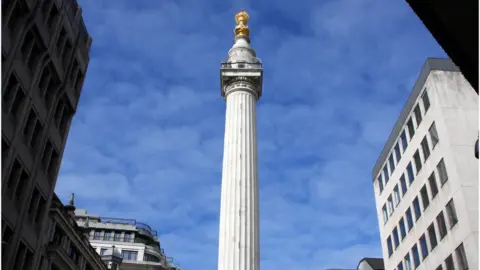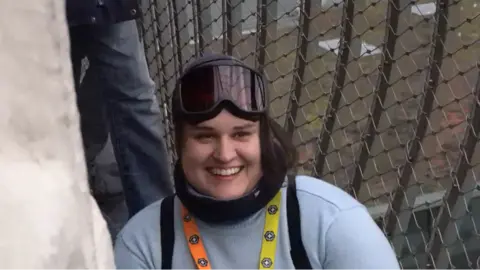First disability activist climbs Great Fire of London Monument
 Norman Mine
Norman MineA woman from London has become the first wheelchair user to climb the Great Fire of London Monument.
Anahita Harding, an artist from Lewisham, south London, climbed the 311-step building using only her arms.
Ms Harding, 30, wants to raise awareness of how hard it is for disabled people to escape from buildings during an emergency.
She previously had to leave a building, which was being evacuated following a kitchen fire, using her arms.
"Usually my friends, if they are around, will wait with me but that is not an ideal situation," Ms Harding said.
"I had a time in the past when a friend carried my wheelchair down and I had to move down the stairs using my arms, which is usually really difficult to do.
"That's the only way to leave the building. It's quite scary."

To climb the structure, Ms Harding spent three hours pushing herself up the Great Fire of London Monument's famous spiral staircase.
She was encouraged by many passers-by to keep going, and several members of the monument's staff accompanied her.
A spokesperson for the Leaseholder Disability Action Group, a group of residents who are disabled or have health conditions and say they are "living in homes affected by the cladding and building safety crisis", said they hoped Ms Harding's climb would make people think.
"The fact that such a demonstration of disabled struggle is needed, in fighting for evacuation plans, is a sad and disturbing reflection on our society.
"No doubt we'll have strong mixed emotions on viewing, but we hope that it will make people think and question this inequality."
Ms Harding also wants to highlight the limited travel options for disabled people in the capital.
 Norman Mine
Norman MineShe explains disabled people either face long journeys on a bus, or have to book a taxi, which can be expensive.
"I try to book an Uber but they do not always have an accessible one. There are just usually two of them in London. They are often fully booked," she said.
When travelling by train, Ms Harding added: "It usually takes one or two days [to book a ramp] and even then they don't always come. Usually, I will travel with someone as I expect that to happen."
'Public consultation'
South Eastern Rail said customers were able to book a ramp two hours in advance and the firm would always provide assistance whether someone had booked or not.
An Uber spokesperson said: "Ensuring that the Uber platform is accessible for all riders is a key priority for us.
"Uber Access is our forward-facing wheelchair-accessible product available in London and cities across the country. Drivers providing these services are specially trained with trips costing no more than a standard UberX fare."
On building safety, a Home Office spokesperson said: "We are committed to delivering proposals that enhance the safety of residents whose ability to self-evacuate in an emergency may be compromised.
"That is why we ran a public consultation on our proposals last year. We are currently analysing the responses to that consultation and will publish a response in due course."

Follow BBC London on Facebook, Twitter and Instagram. Send your story ideas to [email protected]
